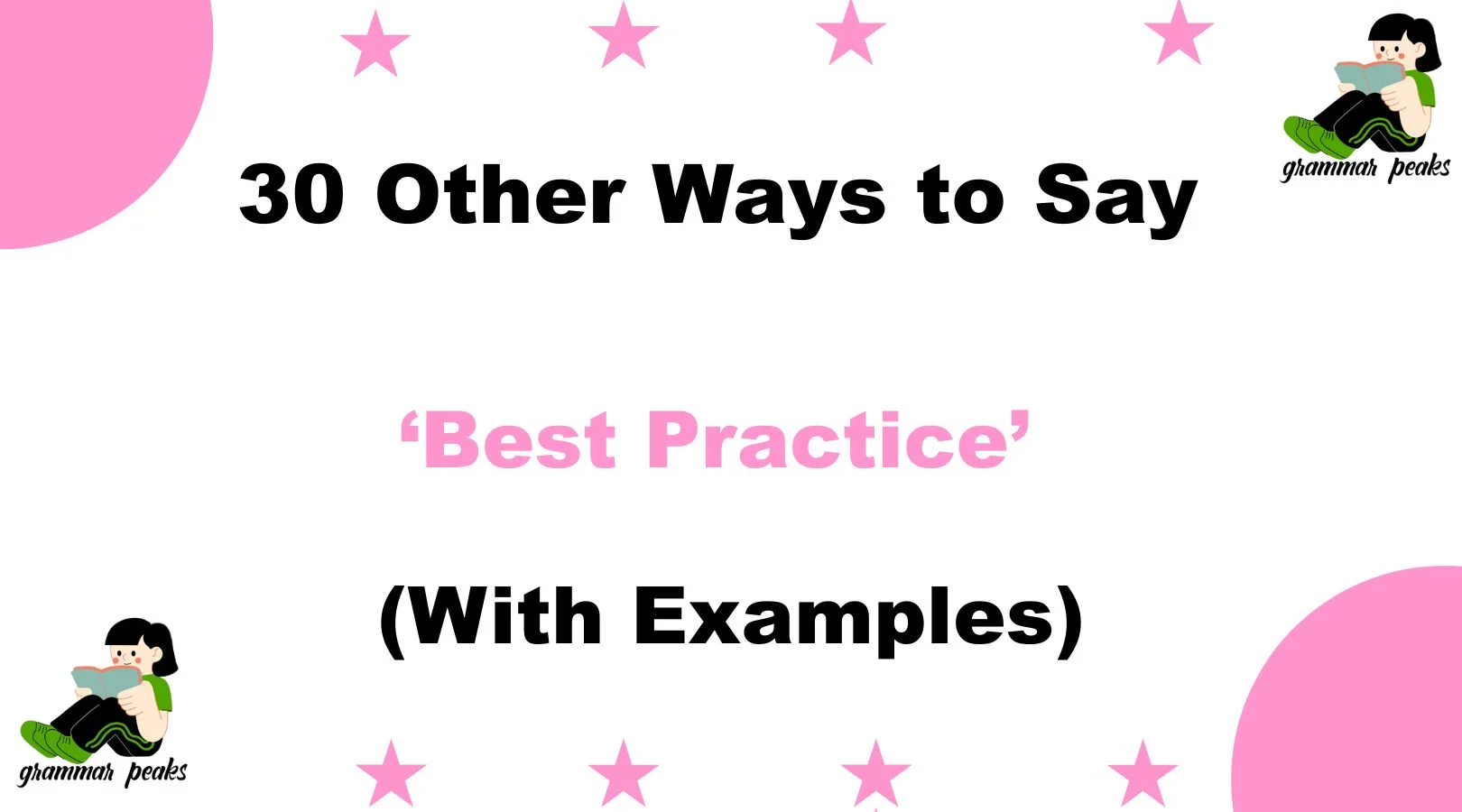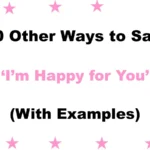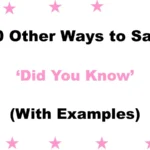Finding the right words to communicate thoughtfully in the workplace can truly elevate the way your message is received. Using a term like ‘best practice’ can often sound rigid or impersonal. If you’re aiming for connection, clarity, and care, choosing an alternative that’s warm, collaborative, or tailored to your audience can go a long way. In this guide, you’ll discover 30 thoughtful, professional alternatives to say ‘best practice’ that still convey expertise—while also resonating more deeply with people. Whether you’re writing an email, creating a report, or having a meeting, these options help you sound more human and intentional.
What Does “Best Practice” Mean?
The term “best practice” refers to a method, approach, or technique that has consistently shown superior results compared to others and is widely accepted as a benchmark. It’s often used in professional settings to describe a process that is proven, efficient, and effective based on experience, research, or industry standards.
The idea is that by following a best practice, individuals or teams are more likely to achieve successful outcomes and avoid common mistakes. While it’s meant to promote consistency and quality, the phrase can sometimes feel impersonal or overly generic, which is why finding more thoughtful, audience-aware alternatives can be a better way to connect and communicate.
When to Use “Best Practice”
Use “best practice” when you want to refer to a method or process that is widely recognized as the most effective way to achieve a specific result. It’s commonly used in training manuals, project planning, policy documents, and team discussions to promote consistency and uphold quality standards.
This phrase is especially helpful when you’re guiding others toward proven approaches or aligning with industry-recognized methods. However, it works best in formal or technical contexts, where precision and reliability are valued. In more personal or collaborative communication, choosing a warmer or more specific alternative can help your message land with greater clarity and care.
Is It Professional/Polite to Say “Best Practice”?
Yes, “best practice” is both professional and polite, especially in formal settings like business meetings, corporate reports, or industry presentations. It signals that a method is well-regarded, reliable, and backed by experience or data, which helps build trust and credibility. However, while it’s polite, it can sometimes come across as vague or overused, particularly if not explained clearly or if your audience prefers more collaborative language. To sound more engaging and inclusive, consider choosing alternatives that feel more specific, human, or team-oriented—especially when working with diverse groups or fostering open discussions.
Pros and Cons of Saying “Best Practice”
Pros:
- Recognized universally
- Conveys authority and reliability
- Suggests consistency and success
Cons:
- Can sound rigid or closed to innovation
- May feel buzzword-heavy or impersonal
- Could alienate creative thinkers
Synonyms for “Best Practice”
- Recommended Approach
- Proven Method
- Trusted Technique
- Standard Procedure
- Established Guideline
- Effective Strategy
- Industry Standard
- Suggested Framework
- Model Example
- Reliable Solution
- Preferred Process
- Time-Tested Method
- Strategic Recommendation
- Recognized Protocol
- Optimal Approach
- Well-Regarded Process
- Demonstrated Strategy
- Refined Methodology
- Commonly Accepted Practice
- Advisable Course of Action
- Consistent Method
- Proficient Technique
- Practical Procedure
- Effective Measure
- Operational Standard
- Guided Approach
- Field-Tested Tactic
- Structured Procedure
- Performance-Proven Plan
- Documented Process
1. Recommended Approach — A helpful phrase when suggesting a method backed by positive results.
Definition: A suggested way of doing something that is considered effective or reliable.
Detailed Explanation: This phrase is gentler than “best practice,” offering direction without pressure, and respects the user’s autonomy.
Scenario Example: “Our recommended approach for resolving client complaints includes a three-step response process.” — Shows guidance without sounding rigid or controlling.
Best Use: In coaching, consultations, or proposals where tone and flexibility matter.
Worst Use: In regulated environments where strict adherence is non-negotiable.
Tone: Supportive, considerate, and professional.
2. Proven Method — Ideal when emphasizing experience and repeatable success.
Definition: A process or strategy that has been tested and shown to work consistently.
Detailed Explanation: Carries confidence and history, emphasizing evidence-based success over time.
Scenario Example: “We use a proven method to streamline content reviews and reduce turnaround time.” — Suggests credibility and efficiency.
Best Use: Business cases, pitches, training materials.
Worst Use: Exploratory discussions or highly creative environments.
Tone: Authoritative, results-focused, confident.
3. Trusted Technique — A good fit when trust and experience are important.
Definition: A reliable method that has earned the confidence of experts or teams.
Detailed Explanation: It emphasizes relationship and reputation, suggesting it’s dependable based on positive outcomes.
Scenario Example: “This trusted technique has helped hundreds of clients improve performance metrics.” — Builds emotional and logical appeal.
Best Use: In testimonials, onboarding guides, and trust-building content.
Worst Use: When introducing entirely new or experimental ideas.
Tone: Warm, reassuring, professional.
4. Standard Procedure — A more structured and technical alternative to “best practice.”
Definition: A documented, repeatable process followed to ensure consistency.
Detailed Explanation: Used to describe formal operations, especially in technical or safety-critical fields.
Scenario Example: “Follow the standard procedure for server maintenance every Friday.” — Enforces routine and accuracy.
Best Use: Technical manuals, SOPs, operations checklists.
Worst Use: In flexible or creative projects.
Tone: Firm, procedural, consistent.
5. Established Guideline — Perfect for offering structure without being too rigid.
Definition: A predefined rule or instruction based on previous success or consensus.
Detailed Explanation: Less rigid than a rule, this gives structure while still allowing for judgment and adaptation.
Scenario Example: “We operate under an established guideline when managing third-party vendors.” — Communicates control and reason.
Best Use: Training materials, organizational handbooks, HR documents.
Worst Use: When rapid innovation or flexibility is required.
Tone: Balanced, informed, structured.
6. Effective Strategy
Definition: A carefully planned method that consistently leads to successful outcomes.
Detailed Explanation: This phrase focuses on the intended result, signaling a method that has proven both efficient and goal-oriented.
Scenario Example: “We implemented an effective strategy for client retention that increased renewals by 40%.” — Shows impact and results.
Best Use: In reporting, project plans, marketing strategies, or case studies.
Worst Use: When discussing untested or new ideas still in development.
Tone: Direct, confident, success-driven.
7. Industry Standard
Definition: A commonly accepted benchmark or method used throughout a specific field or profession.
Detailed Explanation: This phrase conveys broad acceptance and authority, often backed by regulation or long-standing use.
Scenario Example: “Data encryption at this level is considered the industry standard for financial applications.” — Establishes credibility and professionalism.
Best Use: Technical documentation, compliance statements, security policies.
Worst Use: In innovative pitches or informal communication.
Tone: Formal, credible, authoritative.
8. Suggested Framework
Definition: A structured outline or approach offered for guidance or consideration.
Detailed Explanation: This phrase gives a flexible and friendly structure, leaving room for adaptation and creativity.
Scenario Example: “We followed a suggested framework for our brand voice that helped align messaging across teams.” — Indicates helpful structure without being demanding.
Best Use: Brainstorming sessions, collaborative projects, content planning.
Worst Use: Legal, medical, or compliance-sensitive contexts that require rigidity.
Tone: Open, supportive, constructive.
9. Model Example
Definition: An ideal or exemplary case used to demonstrate how something should be done.
Detailed Explanation: Highlights perfection or excellence, useful for showing what success looks like in action.
Scenario Example: “Her project served as a model example for cross-functional teamwork.” — Uses admiration to encourage others to follow.
Best Use: Performance reviews, leadership coaching, educational content.
Worst Use: When referencing evolving methods or new concepts.
Tone: Inspirational, polished, respectful.
10. Reliable Solution
Definition: A dependable approach that consistently solves a particular problem or need.
Detailed Explanation: Emphasizes trustworthiness and dependability, showing it works well under pressure or across time.
Scenario Example: “This software is our most reliable solution for remote team collaboration.” — Shows confidence in effectiveness.
Best Use: IT support, client presentations, customer success stories.
Worst Use: In experimental or evolving situations with many unknowns.
Tone: Confident, clear, steady.
11. Preferred Process
Definition: A favored way of doing things due to its consistent effectiveness.
Detailed Explanation: This phrase reflects a popular or recommended approach, often shaped by experience and feedback.
Scenario Example: “Our preferred process for onboarding reduces friction and improves early retention.” — Suggests team consensus and success.
Best Use: Internal documentation, training, or casual professional communication.
Worst Use: In strictly regulated fields needing formal compliance.
Tone: Friendly, collaborative, pragmatic.
12. Time-Tested Method
Definition: An approach that has stood the test of time through repeated use and reliability.
Detailed Explanation: Communicates longevity and trust, indicating that the approach has worked well over many instances.
Scenario Example: “We rely on a time-tested method for structuring client proposals that win more business.” — Implies heritage and effectiveness.
Best Use: Tradition-based industries, client reassurance, team alignment.
Worst Use: When discussing cutting-edge or highly innovative topics.
Tone: Trustworthy, dependable, traditional.
13. Strategic Recommendation
Definition: A carefully considered suggestion aimed at achieving a specific goal.
Detailed Explanation: Adds weight by combining planning and intention, perfect for guiding others toward thoughtful action.
Scenario Example: “Our strategic recommendation is to consolidate vendors for greater efficiency.” — Adds smart reasoning behind the advice.
Best Use: Consulting, presentations, C-suite conversations.
Worst Use: In tactical or reactive settings.
Tone: Thoughtful, formal, goal-oriented.
14. Recognized Protocol
Definition: An officially accepted and standardized procedure.
Detailed Explanation: Suggests the method is endorsed by authority or expertise, often used in healthcare, law, or tech.
Scenario Example: “This is the recognized protocol for handling sensitive data under GDPR.” — Adds legitimacy and compliance.
Best Use: Regulated industries, technical standards, documentation.
Worst Use: In creative or idea-driven discussions.
Tone: Formal, compliance-focused, institutional.
15. Optimal Approach
Definition: The most effective or efficient way to achieve the desired result.
Detailed Explanation: Positions the method as the best balance between results and resources, usually after careful evaluation.
Scenario Example: “The optimal approach here would be phased rollout to test engagement first.” — Suggests strategic efficiency.
Best Use: Product planning, strategy sessions, performance reviews.
Worst Use: When choices are subjective or context-heavy.
Tone: Intelligent, analytical, positive.
16. Well-Regarded Process
Definition: A process respected and valued by peers or within the industry.
Detailed Explanation: Adds social proof and reputation credibility, ideal for group adoption or leadership buy-in.
Scenario Example: “We’re adopting a well-regarded process used by leading firms in our space.” — Encourages trust by mentioning reputation.
Best Use: Executive summaries, team transitions, industry reports.
Worst Use: When referencing early-stage or local-only methods.
Tone: Professional, respectful, reputation-focused.
17. Demonstrated Strategy
Definition: A plan of action that has shown measurable success through application.
Detailed Explanation: Suggests proof through results, helping convince skeptical audiences.
Scenario Example: “This demonstrated strategy helped us increase retention by 30% year-over-year.” — Connects directly to performance.
Best Use: KPI discussions, reporting, investment proposals.
Worst Use: When discussing theories or brainstorming.
Tone: Evidence-based, confident, performance-driven.
18. Refined Methodology
Definition: A carefully improved and polished process over time.
Detailed Explanation: Emphasizes iteration and thoughtfulness, showing maturity in the process.
Scenario Example: “Our refined methodology evolved through years of testing and feedback.” — Suggests quality and continuous improvement.
Best Use: Product teams, training, advanced workflows.
Worst Use: In brand-new or early-phase initiatives.
Tone: Sophisticated, methodical, experienced.
19. Commonly Accepted Practice
Definition: A method that is widely used and agreed upon within a community or field.
Detailed Explanation: Establishes group consensus and trust, suggesting you’re not reinventing the wheel.
Scenario Example: “It’s a commonly accepted practice to follow up with leads within 24 hours.” — Sets a shared standard.
Best Use: Industry benchmarks, onboarding, group policies.
Worst Use: In contrary or disruptive contexts.
Tone: Neutral, safe, familiar.
20. Advisable Course of Action
Definition: A wise or sensible direction to take based on context and goals.
Detailed Explanation: Implies careful consideration and wisdom, especially useful in sensitive scenarios.
Scenario Example: “Given the data, the advisable course of action is to delay the launch.” — Shows calm and clarity.
Best Use: Risk analysis, policy discussions, executive briefings.
Worst Use: For fast, reactive, or informal communications.
Tone: Considerate, balanced, thoughtful.
21. Consistent Method
Definition: A reliable and uniform process that delivers predictable results.
Detailed Explanation: Highlights reliability and uniformity, especially useful in operational environments.
Scenario Example: “We use a consistent method for quality checks across all product lines.” — Reassures through predictability.
Best Use: Manufacturing, QA, service delivery.
Worst Use: In creative or highly personalized fields.
Tone: Steady, dependable, structured.
22. Proficient Technique
Definition: A skilled and capable method used by experienced individuals.
Detailed Explanation: Focuses on expertise and mastery, often for advanced or technical actions.
Scenario Example: “She applied a proficient technique to resolve the bug within minutes.” — Shows competence.
Best Use: Peer recognition, professional feedback, training.
Worst Use: Entry-level or general advice.
Tone: Skilled, respectful, polished.
23. Practical Procedure
Definition: A functional and easily applied set of steps that work in real-world settings.
Detailed Explanation: Emphasizes real-world usability, favoring application over theory.
Scenario Example: “Let’s stick to a practical procedure that doesn’t overwhelm the team.” — Appeals to realism.
Best Use: Operations, small teams, client onboarding.
Worst Use: High-level strategy or abstract discussions.
Tone: Grounded, useful, direct.
24. Effective Measure
Definition: An action or step that produces a meaningful and measurable impact.
Detailed Explanation: Focuses on efficiency and outcome, especially during assessments or rollouts.
Scenario Example: “Increasing touchpoints was an effective measure to improve engagement.” — Ties directly to results.
Best Use: Campaign reviews, performance evaluations.
Worst Use: Brainstorming or untested settings.
Tone: Focused, analytical, actionable.
25. Operational Standard
Definition: A fixed benchmark or rule used to maintain consistency in day-to-day activities.
Detailed Explanation: Indicates expectation and structure, especially in logistics and technical settings.
Scenario Example: “This is part of our operational standard for service calls.” — Makes procedures non-negotiable.
Best Use: Compliance, safety, IT operations.
Worst Use: In high-level ideation or brand conversations.
Tone: Firm, institutional, routine-based.
26. Guided Approach
Definition: A path forward that includes instruction or direction, often to support decision-making.
Detailed Explanation: Offers clarity and help, without enforcing control — helpful for onboarding or change management.
Scenario Example: “We’ll follow a guided approach for integrating the new software.” — Shows support and direction.
Best Use: Coaching, training, transitions.
Worst Use: High-autonomy roles or expert teams.
Tone: Nurturing, instructional, helpful.
27. Field-Tested Tactic
Definition: A strategy that has been proven through real-world application and feedback.
Detailed Explanation: Carries practical validation, especially from frontline or hands-on experiences.
Scenario Example: “This field-tested tactic reduced ticket handling time by 20%.” — Builds trust from hands-on use.
Best Use: Sales, field ops, product demos.
Worst Use: Academic or theoretical contexts.
Tone: Practical, performance-driven, informal.
28. Structured Procedure
Definition: A clearly defined and organized set of actions to achieve a goal.
Detailed Explanation: Helps with order and clarity, especially useful in detailed environments like finance or legal.
Scenario Example: “We use a structured procedure for quarterly audits to ensure full accuracy.” — Encourages trust through order.
Best Use: Audits, workflows, multi-step operations.
Worst Use: Agile, creative, or rapid-iteration contexts.
Tone: Formal, organized, professional.
29. Performance-Proven Plan
Definition: A plan backed by data and success metrics from past execution.
Detailed Explanation: Combines credibility and performance, especially strong in client-facing materials.
Scenario Example: “We followed a performance-proven plan for our marketing rollout that boosted reach by 60%.” — Data-backed success.
Best Use: Strategy decks, investor pitches, team briefings.
Worst Use: In planning for brand-new services.
Tone: Assertive, data-driven, reliable.
30. Documented Process
Definition: A process that is recorded and available for others to follow or audit.
Detailed Explanation: Adds transparency and repeatability, essential for compliance and training.
Scenario Example: “We follow a documented process for onboarding to maintain consistency.” — Sets a clear, shareable standard.
Best Use: SOPs, team handbooks, compliance workflows.
Worst Use: In rapidly changing environments.
Tone: Clear, traceable, reliable.
Conclusion
Choosing the right words isn’t just about sounding smart—it’s about building trust, showing empathy, and creating clarity in every interaction. Replacing the phrase “best practice” with thoughtful alternatives can elevate your communication, whether you’re writing an email, leading a meeting, or presenting a strategy. Each alternative shared here offers a unique tone—from formal and structured to collaborative and warm—allowing you to match your language with your intentions and audience.
These expressions help remove jargon and make your message feel more human and relatable. The best language is the one that resonates, respects, and reflects care. With this list, you’re now equipped with powerful phrasing to engage professionally and meaningfully. So next time you’re tempted to use “best practice,” you’ve got 30 better ways to say it—and say it well.
FAQs
1. What can I say instead of “best practice” in a formal email?
You can say “recommended standard,” “optimal approach,” or “recognized protocol” to keep your tone professional and clear. These terms fit well in business settings without sounding robotic.
2. Is “best practice” considered overused or outdated?
Yes, in many industries, “best practice” feels generic or vague. Replacing it with something more descriptive or contextual helps your message sound more thoughtful and specific.
3. How do I choose the best alternative from this list?
It depends on your audience, context, and tone. If you’re writing a casual team update, try “preferred process”. For a formal proposal, opt for “strategic recommendation” or “documented process.”
4. Do these alternatives work in technical industries too?
Absolutely. Options like “recognized protocol,” “structured procedure,” and “documented process” are ideal for engineering, healthcare, law, and IT where precision matters.
5. Can I use these alternatives in presentations and reports?
Yes. These phrases not only improve clarity but also boost your credibility. They show that you’ve thought about your message—and your audience—making your communication more impact.

Mariah Cannon is a dedicated Senior Content Specialist at GrammarPeaks, known for her clear, engaging writing and deep knowledge of English grammar and usage. With a background in linguistics and years of experience in content development, Mariah crafts informative and accessible articles that empower readers to master the nuances of the English language. Her work reflects a commitment to clarity, education, and helping others express themselves with confidence.





